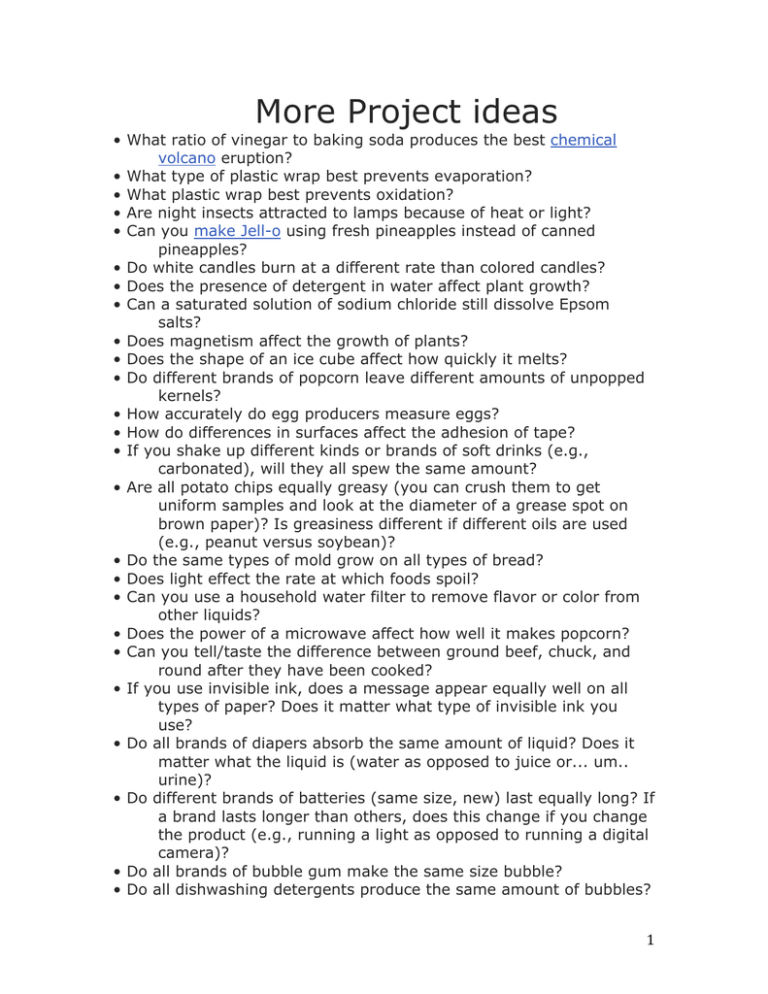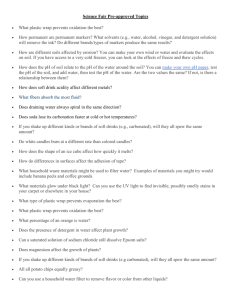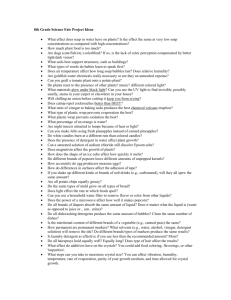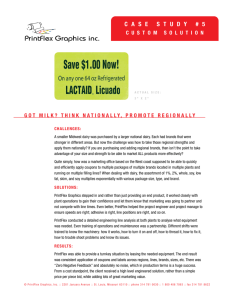More Project ideas
advertisement

More Project ideas • What ratio of vinegar to baking soda produces the best chemical volcano eruption? • What type of plastic wrap best prevents evaporation? • What plastic wrap best prevents oxidation? • Are night insects attracted to lamps because of heat or light? • Can you make Jell-o using fresh pineapples instead of canned pineapples? • Do white candles burn at a different rate than colored candles? • Does the presence of detergent in water affect plant growth? • Can a saturated solution of sodium chloride still dissolve Epsom salts? • Does magnetism affect the growth of plants? • Does the shape of an ice cube affect how quickly it melts? • Do different brands of popcorn leave different amounts of unpopped kernels? • How accurately do egg producers measure eggs? • How do differences in surfaces affect the adhesion of tape? • If you shake up different kinds or brands of soft drinks (e.g., carbonated), will they all spew the same amount? • Are all potato chips equally greasy (you can crush them to get uniform samples and look at the diameter of a grease spot on brown paper)? Is greasiness different if different oils are used (e.g., peanut versus soybean)? • Do the same types of mold grow on all types of bread? • Does light effect the rate at which foods spoil? • Can you use a household water filter to remove flavor or color from other liquids? • Does the power of a microwave affect how well it makes popcorn? • Can you tell/taste the difference between ground beef, chuck, and round after they have been cooked? • If you use invisible ink, does a message appear equally well on all types of paper? Does it matter what type of invisible ink you use? • Do all brands of diapers absorb the same amount of liquid? Does it matter what the liquid is (water as opposed to juice or... um.. urine)? • Do different brands of batteries (same size, new) last equally long? If a brand lasts longer than others, does this change if you change the product (e.g., running a light as opposed to running a digital camera)? • Do all brands of bubble gum make the same size bubble? • Do all dishwashing detergents produce the same amount of bubbles? 1 Clean the same number of dishes? • Is the nutritional content of different brands of a vegetable (e.g., canned peas) the same? • How permanent are permanent markers? What solvents (e.g., water, alcohol, vinegar, detergent solution) will remove the ink? Do different brands/types of markers produce the same results? • Do consumers prefer bleached paper products or natural-color paper products? Why? • Is laundry detergent as effective if you use less than the recommended amount? More? • Do all hairsprays hold equally well? Equally long? Does type of hair affect the results? • How does the rate of evaporation of the crystal-growing medium affect the final size of the crystals? You can change the rate of evaporation by sealing the container (no evaporation at all if there is no air space) or by blowing a fan over the liquid or enclosing the jar of medium with a dessicant. Different places and seasons will have different humidities. The crystals grown in a desert may be different from those grown in a rain forest. • How do crystals grown from uniodized salt compare with those grown from iodized salt? • How do different factors affect seed germination? Factors that you could test include the intensity, duration, or type of light, the temperature, the amount of water, the presence/absence of certain chemicals, or the presence/absence of soil. You can look at the percentage of seeds that germinate or the rate at which seeds germinate. • Is a seed affected by its size? Do different size seeds have different germination rates or percentages? Does seed size affect the growth rate or final size of a plant? • How does cold storage affect the germination of seeds? Factors you can control include the type of seeds, length of storage, temperature of storage, light and humidity. • What conditions affect the ripening of fruit? Look at ethylene and enclosing a fruit in a sealed bag, temperature, light, or nearness to other pieces or fruit. • How are different soils affected by erosion? You can make your own wind or water and evaluate the effects on soil. If you have access to a very cold freezer, you can look at the effects of freeze and thaw cycles. • How does the pH of soil relate to the pH of the water around the soil? You can make your own pH paper, test the pH of the soil, add water, then test the pH of the water. Are the two values the same? If not, is there a relationship between them? 2 • How close does a plant have to be to a pesticide for it to work? What factors influence the effectiveness of a pesticide (rain? light? wind?)? How much can you dilute a pesticide while retaining its effectiveness? How effective are natural pest deterrents? • What is the effect of a chemical on a plant? You can look at natural pollutants (e.g., motor oil, runoff from a busy street) or unusual substances (e.g., orange juice, baking soda). Factors that you can measure include rate of plant growth, leaf size, life/death of the plant, color of plant, and ability to flower/bear fruit. • Do clear flavored drinks and colored flavored drinks (same flavor) taste the same? Does it matter if you can see the color? 3





